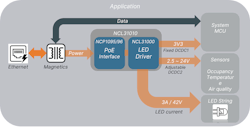What you’ll learn:
- Why digitizing lighting is important.
- How PoE-based lighting will improve smart buildings.
Designers of smart homes, offices, and factories constantly seek new ways to improve the efficiency of the systems used to deliver and manage building facilities. Historically, data and power networks were installed separately with the intention of each performing a distinctly different function, but this required the installation of two completely different cable types within the structure of the building.
The development of Power over Ethernet (PoE) now offers a way to reduce the requirement for ac mains power cabling by letting some devices (such as cameras, phones, wireless routers) instead draw power from their data cables. One area that’s garnering more attention as a potential application for PoE is lighting.
In this article, we investigate the role that connected lighting systems can play in the deployment and management of smart building systems and consider the potential relationship between lighting and building automation (Fig. 1). We also review the standard approach to their design and explain how to enable new applications for connected lighting systems, while greatly simplifying their design.
Connected Lighting and Building Automation
Once inside a building, whether domestic, commercial, or industrial, lighting is ubiquitous. In recent times, inefficient incandescent and halogen light bulbs have been largely replaced by lower power and much more efficient LEDs. However, the method for powering lights hasn’t changed significantly, with cabling still being routed to the locations where light fittings (luminaires) will be installed.
Since LEDs require dc power, luminaires must include an ac-dc transformer and potentially a dc-dc converter to provide the LED with its required voltage level, and ultimately the controlling current. While delivering effective lighting, this approach, which considers luminaires responsible for a single function—lighting—completely neglects the fact that they’re ideally positioned to host a range of other smart-building functions.
The first step in exploiting the ubiquity of light fittings is to give them digital connectivity. By digitizing individual luminaires and interconnecting them to a unified system, they can serve as a backbone that’s ideal for hosting IoT applications throughout the building.
In a connected lighting system, every luminaire would have a unique IP address that enables two-way data communication over the building’s data network. Connected lighting is an obvious candidate for carrying IoT data in houses, offices, and factories because electrical and data communications networks are already in place. This approach would let connected luminaires host other sensor capabilities with countless applications.
By integrating different types of smart sensors (temperature, humidity, proximity, air quality, etc.), a connected lighting system could simultaneously capture data about occupancy and other environmental metrics in rooms all over a building that would serve as actionable inputs into smart-building automation systems. This information could assist with space optimization, operational effectiveness, and help maximize comfort inside the building. Insights on occupant behavior collected also could be used for energy-management purposes.
Implementing a Connected Lighting System
One way to add digital connectivity to luminaires would be to include a Wi-Fi radio. However, since wireless RF signals suffer from varying levels of attenuation, depending on their location and building materials between them and the closest access point, itcould lower the speed and reliability of data communication.
A better approach is to provide each luminaire with an Ethernet interface. But this would require routing Cat5/6 twisted-pair cables to each light fitting, doubling the amount of cabling (assuming mains cabling is already planned), and increasing the cost and effort of installation.
Ideally, connected lighting should only require one cable carrying power to LEDs, cameras, and smart sensors, and taking bidirectional data from them to a remote controller. This would eliminate the need for separate mains cabling to be routed to each luminaire—a significant advantage. PoE can carry dc voltage to power devices and network data at the speed of the implemented Ethernet standard, making it well-suited for this task.
Fully Integrated Solution
PoE-connected luminaires use separate driver ICs for the LED and a PoE interface IC to source the power via Ethernet. Taking a different approach, the NCL31010 developed by onsemi combines both components in a single package that can be used as the basis for fully connected and managed lighting systems (Fig. 2).
This device is PoE-compliant (enabling the delivery of over 90 W of system power) and is certified to IEEE802.3bt/at/af. Its buck LED driver is 97% efficient and supports high-bandwidth high-linearity analog and PWM dimming (down to zero current). Spread-spectrum techniques help reduce the amount of conducted and radiated EMI.
Two auxiliary dc-dc converters in the device can power a microcontroller and additional peripherals, such as sensors. Also included are high-accuracy metrology and diagnostic features to measure input and output current and voltage, LED or system temperature, dc-dc voltages, and currents. An application for this device is low-data-rate visible light communication (VLC). In this application, digital data is modulated onto the LED light emitted from a luminaire, enabling to become a location beacon in indoor positioning systems (e.g., YellowDot). Modulated data in VLC is imperceptible to the human eye.
Future-Proof Lighting
PoE-based connected lighting offers the most flexible and efficient lighting for all types of future smart buildings, with LED luminaires controlled via the data network and powered via the data cabling. By using a combination of sensors, intelligent luminaires, and intelligent control systems, smart buildings will provide levels of comfort and efficiency unachievable with conventional lighting. Those managing smart building systems also will enjoy lower costs during construction and after the building is fully occupied and operational.


